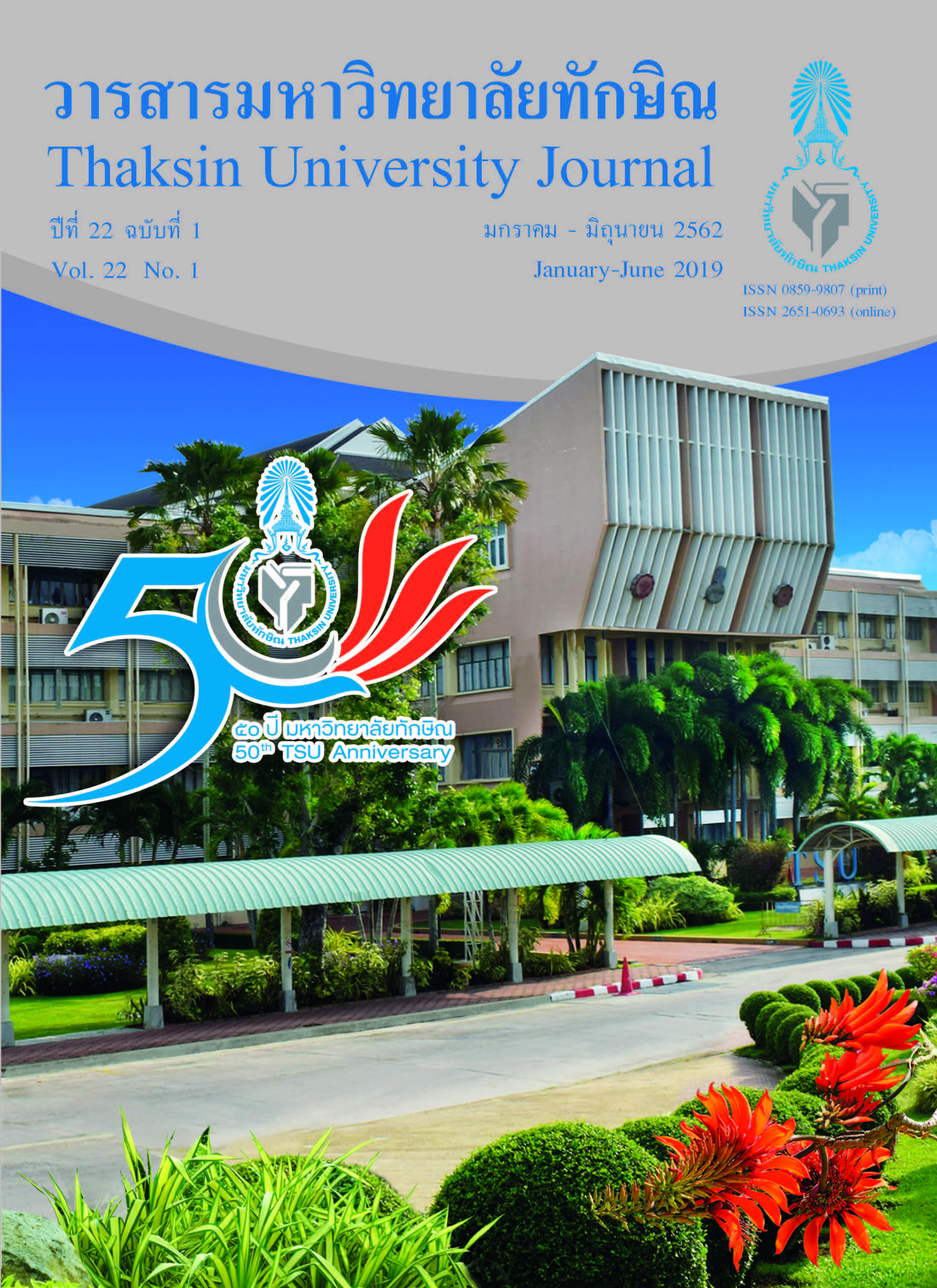การประเมินผลของสเปรย์ดับกลิ่นเท้าที่มีสารสกัดของใบพลู
Main Article Content
บทคัดย่อ
ปัญหากลิ่นเท้าเป็นปัญหาที่หลาย ๆ คนต้องเผชิญในชีวิตประจำวัน ในการศึกษานี้จึงได้ทำการศึกษา
การสกัดสารสกัดจากใบพลูด้วยเอทานอล เพื่อนาสารสกัดที่ได้ไปเป็นส่วนผสมในผลิตภัณฑ์ป้องกันการเกิดกลิ่นเท้า
และพัฒนาให้เป็นตา รับสเปรย ์ ในการศึกษาการกลบกลิ่นของสารสกัดใช้เทคนิคเครื่องแก๊สโครมาโทรกราฟี -
แมสสเปคโทรมิเตอร์และวิธีการดมกลิ่น การพัฒนาสูตรตารับสเปรย์บาบัดกลิ่นเท้า พบว่าสูตรที่มีสารสกัดจากใบพลู
ร้อยละ 0.1 มี Aluminium Chlorohydrate Solution ร้อยละ 30 มี Propylene Glycol ร้อยละ 5 มี Glycerin ร้อยละ 2
มี Butylhydroxyl Anisole ร้อยละ 0.1 และมี Paraben Concentrate ร้อยละ 1 ใหสู้ตรตา รับที่ดีคือ ละอองของสเปรย์แห้งเร็ว
และไม่มันเยิ้มเคลือบผิวหลังการใช้งาน การศึกษาการยับยั้งเชื้อแบคทีเรียที่ก่อให้เกิดกลิ่นเท้าด้วยสูตรสเปรย์ที่มีสาร
สกัดจากใบพลูพบว่า ผลิตภัณฑ์สเปรย์ที่มีสารสกัดจากใบพลูสามารถยับยั้งการเจริญของเชื้อ Staphylococcus
epidermidis ATCC12228 และ Bacillus subtilis ATCC6633 โดยมีเส้นผ่านศูนย์กลางของโซนใสยับยั้งเชื้อเป็น
14.77 ± 0.21 mm และ 14.0 ± 0.35 mm ตามลำดับ
Article Details

This work is licensed under a Creative Commons Attribution-NonCommercial-NoDerivatives 4.0 International License.
References
Oxford: Blackwell Science Ltd.
[2] Benohanian, A. (2001). Antiperspirants and Deodorants. Clinics in Dermatology, 19, 398-405.
[ 3] Dwivedi, V., & Tripathi, S. ( 2014) . Review Study on Potential Activity of Piper betle. Journal of
Pharmacognosy and Phytochemistry, 3, 93-98.
[4] Khan, J. A., & Kumar, N. (2011). Evaluation of Antibacterial Properties of Extracts of Piper betel Leaf.
Journal of Pharmaceutical and Biomedical Sciences, 11, 1-3.
[5] Ali, I., Khan, F. G., Suri, K. A., Gupta, B. D., Satti, N. K., Dut, T. P., Afrin, F., Qazi, G. N., & Khan, I. A.
(2010). In Vitro Antifungal Activity of Hydroxychavicol Isolated from Piper betle L. Annals of Clinical
Microbiology and Antimicrobials, 9, 7-15.
[6] Caburian, A. B., & Osi, M. O. (2010). Characterization and Evaluation of Antimicrobial Activity of the
Essential Oil from the Leaves of Piper betle L. E-International Scientific Research Journal, 2, 2-13.
[7] Nanayakkara, B. S., Abayasokara, C. L., & Panagoda, G. J. (2014). Anti-candidal Activity of Piper betle (L.),
Vitex negundo (L.) and Jasminum grandiflorum. African Journal of Microbiology Research, 8, 2307-2314.
[8] Natthaya, P. (2009). Development of Foot Spray Product using Essential Oil in Inhibitory Micrococcus
sedentarius Growth. Master's Thesis. Kasetsart University.
[9] Ara, K., Hama, M., Akiba, S., Koike, K., Okwasaka, K., Hagura, T., Kamiya, T., & Tomita, F. (2006). Foot Odor
Due to Microbial Metabolism and Its Control. Canadian Journal of Microbiology, 52, 357-364.
[10] Subashkumar, R., Sureshkumar, M., Babu, S., & Thayumanavan, T. (2013). Antibacterial Effect of Crude
Aqueous Extract of Piper betle L. Against Pathogenic Bacteria. International Journal of Research
in Pharmaceutical and Biomedical Sciences, 4, 42-46.
[11] Inam, F., Deo, S., & Narkhede, N. (2014). HPLC-UV Method Development and Quantification of Eugenol
from Methanolic Extracts of Some Spices. International Journal of Chemical and Physical Sciences,
3, 96-102.
[12] Caroprese, A., Gabbanini, S., Beltramini C., Lucchi, E., & Valgimigli, L. (2009). HS-SPME-GC-MS
Analysis of Body Odor to Test the Efficacy. Skin Research and Technology, 15, 503-510.
[13] Kim, K. H. , & Park, S. Y. ( 2008) . A Comparative Analysis of Malodor Samples between Direct
(Olfactometry) and Indirect (Instrumental) Methods. Atmospheric Environment, 42, 5061-5070.
[14] Martell, M. J., & Boothe, J. H. ( 1967) . The 6-deoxytetracyclines VII Alkylated Aminotetracyclines
Possessing Unique Antibacterial Activity. Journal of Medicinal and Pharmaceutical Chemistry,
10, 44-46.

